The Effectiveness of Selected Devices to Reduce the Speed of Vehicles on Pedestrian Crossings
Abstract
:1. Introduction—Reasons to Reduce the Vehicles Speed on Pedestrian Crossings
2. The Description of Devices Used to Reduce the Vehicles Speed with a Presentation of the Research of Their Effectiveness
- The mean speed is 26 km/h and mean geometric parameters, length, L = 8.96 m and height, H = 10.82 cm,
- The logarithmic function is the most appropriate to describe the relationship between the geometric parameters and the reduction of speed,
- There is a large impact of the road width on speed,
- The following geometric parameters have a significant effect on the speed: ramp gradient, table length, and height.
- 170 m between the speed bumps and 145 m between the speed tables, for a speed of min. 50 km/h;
- 85 m between the speed bumps and 70 m between the speed tables, for a speed of max. 40–45 km/h.
- 80% of the vehicles slowed down at the hump by 65% compared to the speed on the preceding section,
- The speed at the bump decreases with the increase of its height.
3. The Studies That Have Been Conducted—Method and Location
4. The Results of Research and Identification of the Three Categories of Devices
- Lrc = 6 m—length of the raised part of the road,
- Rrc = 1 m—length of ramp (between raised and non-raised part of road),
- Hrc = 0.15 m—height of raising,
- Wrc = 6 m—width of pedestrian crossing,
- W = 6.5 m—width of road.
- Lh = 3.7 m—length of table,
- Dh = 6 m—distance between table and pedestrian crossing,
- Hh = 0.08 m—height of table,
- Wh = 2 m—width of table,
- Wl = 3.5 m—width of lane,
- La = 2.5 m—length of refugee island,
- Wa = 2.5 m—width of refugee island.
- Lrc = 7 m—length of the raised part of the road,
- Rrc = 1.8 m—length of ramp (between pedestrian crossing and non-raised road),
- Hrc = 0.09 m—height of raising,
- Wrc = 6.5 m—width of crossing,
- W = 7 m—width of road.
- Lh = 3.7 m—length of table,
- Dh = 25 m—distance between table and pedestrian crossing,
- Hh = 0.07 m—height of table,
- Wh = 5.5 m—width of table,
- W = 6 m—width of road,
- D = 100 m—distance between tables.
- La = 2 m—length of refugee island,
- Ha = 0.1 m—width of asylum in refugee island,
- S = 1/10—slope of narrowing,
- Wa = 2 m—width of refugee island,
- Wl = 3 m—width of lane,
- W = 8 m—width of road.
- La = 2 m—length of refugee island,
- Ha = 0.1 m—width of asylum in refugee island,
- Da = 3 m—distance between the beginning of the mid-block and pedestrian crossing,
- S = 1/3—slope of narrowing,
- Wa = 2 m—width of refugee island,
- Wl = 3 m—width of lane,
- W = 9 m—width of road.
5. Discussion
6. Conclusions and Comments
- There is a wide difference in the impact of the tested devices on speed, and so alters the effectiveness and legitimacy of their use in order to improve pedestrian safety.
- The greatest reduction of speed in the cross-section P0 is caused by raised pedestrian crossing, as evidenced by positive values of the relative rate of the change of speed ZV.
- The speed reduction effect along the longer segment of the road (from cross section P1 to cross section P0) is observed when the road is equipped with speed tables.
- The presence of the refugee island themselves does not significantly reduce the speed of vehicles, the speed value at pedestrian crossings with the island exceeds the (safe) speed limit.
- Similar values of the coefficient of variation WZv in cross section P0 in relation to cross section P1 obtained for speed tables and refugee islands indicate a smaller (than for raised pedestrian crossings) impact of these devices on the change of driving style (including speed) near pedestrian crossings.
- The majority of drivers reach the value of speed only slightly higher than the safe value (30 km/h) in places equipped with raised pedestrian crossings and speed tables.
Author Contributions
Funding
Informed Consent Statement
Data Availability Statement
Conflicts of Interest
References
- McKinley, T.; Williams, T.M.; Jones, J. The epidemiology of pedestrian fatalities and substance use in Georgia, United States, 2007–2016. Accid. Anal. Prev. 2020, 134, 105329. [Google Scholar]
- Gaca, S.; Kieć, M. Assessment of pedestrian risk at crossings using kinematic- probabilistic model. Transp. Res. Board 2015, 2514, 129–137. [Google Scholar] [CrossRef]
- Guéguen, N.; Meineri, S.; Eyssartier, C. A pedestrian’s stare and drivers’ stopping behavior: A field experiment at the pedestrian crossing. Saf. Sci. 2015, 75, 87–89. [Google Scholar] [CrossRef]
- Balasubramanian, V.; Bhardwaj, R. Pedestrians’ perception and response towards vehicles during road-crossing at nighttime. Accid. Anal. Prev. 2018, 110, 128–135. [Google Scholar] [CrossRef] [PubMed]
- Li, Y.; Fan, W. Modelling severity of pedestrian-injury in pedestrian-vehicle crashes with latent class clustering and partial proportional odds model: A case study of North Carolina. Accid. Anal. Prev. 2019, 131, 284–296. [Google Scholar] [CrossRef]
- Debnath, M.; Hasanat-E-Rabbi, S.; Hamim, O.F.; Hoque, M.d.S.; McIlroy, R.C.; Plant, K.L.; Stanton, N.A. An investigation of urban pedestrian behaviour in Bangladesh using the Perceptual Cycle Model. Saf. Sci. 2021, 138, 105214. [Google Scholar] [CrossRef]
- Sun, M.; Sun, X.; Shan, D. Pedestrian crash analysis with latent class clustering method. Accid. Anal. Prev. 2019, 124, 50–57. [Google Scholar] [CrossRef]
- Lee, J.; Abdel-Aty, M.; Xu, P.; Gong, Y. Is the safety-in-numbers effect still observed in areas with low pedestrian activities? A case study of a suburban area in the United States. Accid. Anal. Prev. 2019, 125, 116–123. [Google Scholar] [CrossRef] [PubMed]
- Sze, N.N.; Su, J.; Bai, L. Exposure to pedestrian crash based on household survey data: Effect of trip purpose. Accid. Anal. Prev. 2019, 128, 17–24. [Google Scholar] [CrossRef]
- Kummeneje, A.M.; Rundmo, T. Risk perception, worry, and pedestrian behaviour in the Norwegian population. Accid. Anal. Prev. 2019, 133, 105294. [Google Scholar] [CrossRef]
- Babi’c, D.; Babi’c, D.; Fioli´c, M.; Ferko, M. Factors affecting pedestrian conspicuity at night: Analysis based on driver eye tracking. Saf. Sci. 2021, 139, 105257. [Google Scholar] [CrossRef]
- Medury, A.; Grembek, O.; Loukaitou-Sideris, A.; Shafizadeh, K. Investigating the underreporting of pedestrian and bicycle crashes in and around university campuses—a crowdsourcing approach. Accid. Anal. Prev. 2019, 130, 99–107. [Google Scholar] [CrossRef]
- Guo, M.; Yuan, Z.; Janson, B.; Peng, Y.; Yang, Y.; Wang, W. Older Pedestrian Traffic Crashes Severity Analysis Based on an Emerging Machine Learning XGBoost. Sustainability 2021, 13, 926. [Google Scholar] [CrossRef]
- Haule, H.J.; Sando, T.; Kitali, A.E.; Richardson, R. Investigating proximity of crash locations to aging pedestrian residences. Accid. Anal. Prev. 2019, 122, 215–225. [Google Scholar] [CrossRef]
- Tapiro, H.; Oron-Gilad, T.; Parmet, Y. The effect of environmental distractions on child pedestrian’s crossing behavior. Saf. Sci. 2018, 106, 219–229. [Google Scholar] [CrossRef]
- Gitelman, V.; Levi, S.; Carmel, R.; Korchatov, A.; Hakkert, S. Exploring patterns of child pedestrian behaviors at urban intersections. Accid. Anal. Prev. 2019, 122, 36–47. [Google Scholar] [CrossRef] [PubMed]
- Ābele, L.; Haustein, S.; Møller, M. Young drivers’ perception of adult and child pedestrians in potential street-crossing situations. Accid. Anal. Prev. 2018, 118, 263–268. [Google Scholar] [CrossRef] [Green Version]
- Lehsing, C.h.; Ruch, F.; Kölsch, F.M.; Dyszak, G.N.; Bowers, A.R. Effects of simulated mild vision loss on gaze, driving and interaction behaviors in pedestrian crossing situations. Accid. Anal. Prev. 2019, 125, 138–151. [Google Scholar] [CrossRef] [PubMed]
- Pešic, D.; Antic, B.; Glavic, D.; Milenkovic, M. The effects of mobile phone use on pedestrian crossing behaviour at unsignalized intersections–Models for predicting unsafe pedestrians behavior. Saf. Sci. 2016, 82, 1–8. [Google Scholar] [CrossRef]
- Pugliese, B.J.; Barton, B.K.; Davis, S.J.; Lopez, G. Assessing pedestrian safety across modalities via a simulated vehicle time-to-arrival task. Accid. Anal. Prev. 2020, 134, 105344. [Google Scholar] [CrossRef]
- Wu, J.; Xu, H.; Zheng, Y.; Tian, Z. A novel method of vehicle-pedestrian near-crash identification with roadside LiDAR data. Accid. Anal. Prev. 2018, 121, 238–249. [Google Scholar] [CrossRef]
- Mukherjee, D.; Mitra, S. A comparative study of safe and unsafe signalized intersections from the view point of pedestrian behavior and perception. Accid. Anal. Prev. 2019, 132, 105218. [Google Scholar] [CrossRef]
- Kruszyna, M.; Rychlewski, J. Influence of approaching tram on behaviour of pedestrians in signalised crosswalks in Poland. Accid. Anal. Prev. 2013, 55, 185–191. [Google Scholar] [CrossRef]
- Li, H.; Wu, D.; Graham, D.J.; Sze, N.N. Comparison of exposure in pedestrian crash analyses: A study based on zonal origin-destination survey data. Saf. Sci. 2020, 131, 104926. [Google Scholar] [CrossRef]
- Gupta, A. Study on Speed Profiles Across Speed Bumbs, Department of Civil Engineering, National Institute of Technology Rourkela. 2014. Available online: http://ethesis.nitrkl.ac.in/5881/1/e-74.pdf (accessed on 30 November 2015).
- Ding, C.; Chen, P.; Jiao, J. Non-linear effects of the built environment on automobile-involved pedestrian crash frequency: A machine learning approach. Accid. Anal. Prev. 2018, 112, 116–126. [Google Scholar] [CrossRef]
- Avinash, C.h.; Jiten, S.; Arkatkar, S.; Gaurang, J.; Manoranjan, P. Investigating effect of surrounding factors on human behaviour at uncontrolled mid-block crosswalks in Indian cities. Saf. Sci. 2019, 119, 174–187. [Google Scholar] [CrossRef]
- Kraidi, R.; Evdorides, H. Pedestrian safety models for urban environments with high roadside activities. Saf. Sci. 2020, 130, 104847. [Google Scholar] [CrossRef]
- Lee, J.; Abdel-Aty, M.; Shah, I. Evaluation of surrogate measures for pedestrian trips at intersections and crash modeling. Accid. Anal. Prev. 2019, 130, 91–98. [Google Scholar] [CrossRef]
- Solmazer, G.; Azık, D.; Fındık, G.; Üzümcüoğlu, Y.; Xheladini, G. Cross-cultural differences in pedestrian behaviors in relation to values: A comparison of five countries. Accid. Anal. Prev. 2020, 138, 105459. [Google Scholar] [CrossRef]
- McIlroy, R.C.; Kokwaro, G.O.; Wu, J.; Jikyong, U.; Stanton, N.A. How do fatalistic beliefs affect the attitudes and pedestrian behaviours of road users in different countries? A cross-cultural study. Accid. Anal. Prev. 2020, 139, 105491. [Google Scholar] [CrossRef] [PubMed]
- Zhang, Y.; Qiao, Y.; Fricker, J.D. Investigating pedestrian waiting time at semi-controlled crossing locations: Application of multi-state models for recurrent events analysis. Accid. Anal. Prev. 2020, 137, 105437. [Google Scholar] [CrossRef]
- Ahangar, A.N.; Arghand, E.; Ahangar, H.B.; Ganji, S.R.S. Recognizing the reasons of the accidents based on the rural drivers’ mental patterns using Q analytical method. Saf. Sci. 2020, 125, 104649. [Google Scholar] [CrossRef]
- Herrero-Fernández, D.; Parada-Fernández, P.; Oliva-Macías, M.; Jorge, R. The influence of emotional state on risk perception in pedestrians: A psychophysiological approach. Saf. Sci. 2020, 130, 104857. [Google Scholar] [CrossRef]
- Rasch, A.; Panero, G.; Boda, C.-N.; Dozza, M. How do drivers overtake pedestrians? Evidence from field test and naturalistic driving data. Accid. Anal. Prev. 2020, 139, 105494. [Google Scholar] [CrossRef]
- Nishimoto, T.; Kubota, K.; Ponte, G. A pedestrian serious injury risk prediction method based on posted speed limit. Accid. Anal. Prev. 2019, 129, 84–93. [Google Scholar] [CrossRef]
- Huang, Z.; He, Y.; Wen, Y.; Song, X. Injured probability assessment in frontal pedestrian-vehicle collision counting uncertainties in pedestrian movement. Saf. Sci. 2018, 106, 162–169. [Google Scholar] [CrossRef]
- Kathuria, A.; Vedagiri, P. Evaluating pedestrian vehicle interaction dynamics at un-signalized intersections: A proactive approach for safety analysis. Accid. Anal. Prev. 2020, 134, 105316. [Google Scholar] [CrossRef] [PubMed]
- Soilán, M.; Riveiro, B.; Sánchez-Rodríguez, A.; Arias, P. Safety assessment on pedestrian crossing environments using MLS data. Accid. Anal. Prev. 2018, 111, 328–337. [Google Scholar] [CrossRef]
- Larue, G.S.; Naweed, A.; Rodwell, D. The road user, the pedestrian, and me: Investigating the interactions, errors and escalating risks of users of fully protected level crossings. Saf. Sci. 2018, 110, 80–88. [Google Scholar] [CrossRef]
- Fu, T.; Miranda-Moreno, L.; Saunier, N. A novel framework to evaluate pedestrian safety at non-signalized locations. Accid. Anal. Prev. 2018, 111, 23–33. [Google Scholar] [CrossRef]
- Mansfield, T.J.; Peck, D.; Morgan, D.; McCann, B.; Teicher, P. The effects of roadway and built environment characteristics on pedestrian fatality risk: A national assessment at the neighborhood scale. Accid. Anal. Prev. 2018, 121, 166–176. [Google Scholar] [CrossRef] [PubMed]
- Bastien, C.; Wellings, R.; Burnett, B. An evidence based method to calculate pedestrian crossing speeds in vehicle collisions (PCSC). Accid. Anal. Prev. 2018, 118, 66–76. [Google Scholar] [CrossRef]
- Rosén, E.; Sander, U. Pedestrian fatality risk as a function of car impact speed. Accid. Anal. Prev. 2009, 41, 536–542. [Google Scholar] [CrossRef]
- Rosen, E.; Sander, U.; Stigson, H. Literature review of pedestrian facility risk as a function of car impact speed. Accid. Anal. Prev. 2011, 43, 25–33. [Google Scholar] [CrossRef]
- Hussain, Q.; Feng, H.; Grzebieta, R.; Brijs, T.; Olivier, J. The relationship between impact speed and the probability of pedestrian fatality during a vehicle-pedestrian crash: A systematic review and meta-analysis. Accid. Anal. Prev. 2019, 129, 241–249. [Google Scholar] [CrossRef] [PubMed]
- Wilmots, B.; Hermans, E.; Brijs, T.; Wets, G. Speed control with and without advanced warning sign on the field: An analysis of the effect on driving speed. Saf. Sci. 2016, 85, 23–32. [Google Scholar] [CrossRef]
- Kang, B. Identifying street design elements associated with vehicle-to-pedestrian collision reduction at intersections in New York City. Accid. Anal. Prev. 2019, 122, 308–317. [Google Scholar] [CrossRef]
- Sundo, M.B.; Diaz, C.E.D. Effect of hump spacing on speed selection of isolated vehicles: The case of exclusive villages in metro manila. In Proceedings of the Eastern Asia Society for Transportation Studies, Hanoi City, Vietnam, 24–27 October 2001; Volume 3. [Google Scholar]
- Basil, D.D.; Nicholson, A.; Koorey, G. Investigating Speed Patterns and Estimating Speed on Traffic-Calmed Streets, IPENZ Transportation Group Conference Auckland. 2011. Available online: http://www.nzta.govt.nz/assets/resources/research/reports/521/docs/rr521.pdf (accessed on 30 November 2015).
- Barbosa, H.M.; Tight, M.R.; May, A.D. A model of speed profiles for traffic calmed roads. Transp. Res. Part. A. 2000, 34, 103–123. [Google Scholar] [CrossRef]
- Falamarzi, A.; Rahmat, O.K. Using Appropriate Speed Tables Regarding to the Speed Limit of Streets Research Journal of Applied Sciences. Eng. Technol. 2014, 7, 2741–2746. [Google Scholar]
- Bian, Y.; Liang, K.; Zhao, X.; Li, H.; Yang, L. Evaluating the effectiveness of new-designed crosswalk markings at intersections in China considering vehicle-pedestrian interaction. Accid. Anal. Prev. 2020, 139, 105498. [Google Scholar] [CrossRef]
- Ma, Y.; Gu, X.; Yu, Y.; Khattakc, A.J.; Chen, S.; Tang, K. Identification of Contributing Factors for Driver’s Perceptual Bias of Aggressive Driving in China. Sustainability 2021, 13, 766. [Google Scholar] [CrossRef]
- Domenichini, L.; Branzi, V.; Meocci, M. Virtual testing of speed reduction schemes on urban collector roads. Accid. Anal. Prev. 2018, 110, 38–51. [Google Scholar] [CrossRef]
- Domenichini, L.; Branzi, V.; Smorti, M. Influence of drivers’ psychological risk profiles on the effectiveness of traffic calming measures. Accid. Anal. Prev. 2019, 123, 243–255. [Google Scholar] [CrossRef] [PubMed]
- Lav, A.H.; Bilgin, E.; ALav, H. A fundamental experimental approach for optimal design of speed bumps. Accid. Anal. Prev. 2018, 116, 53–68. [Google Scholar] [CrossRef]
- Gupta, S.; Vasardani, M.; Lohani, B.; Winter, S. Pedestrian’s risk-based negotiation model for self-driving vehicles to get the right of way. Accid. Anal. Prev. 2019, 124, 163–173. [Google Scholar] [CrossRef] [PubMed]
- Avinash, C.; Jiten, S.; Arkatkar, S.; Gaurang, J.; Manoranjan, P. Evaluation of pedestrian safety margin at mid-block crosswalks in India. Saf. Sci. 2019, 119, 188–198. [Google Scholar] [CrossRef]
- Zeeger, C. Pedestrian Facilities User Guide-Providing Safety and Mobility; UNC Highway Safety Reasearch Center: Chapel Hill, NC, USA, 2000. [Google Scholar]
- Bąk, R.; Kieć, M. Influence of various types of mid- block pedestrian crossings on urban street capacity, Transportation Research Record. J. Transp. Res. Board 2012, 2316, 76–83. [Google Scholar] [CrossRef]
- Zhang, C.; Chen, F.; Wei, Y. Evaluation of pedestrian crossing behavior and safety at uncontrolled mid-block crosswalks with different numbers of lanes in China. Accid. Anal. Prev. 2019, 123, 263–273. [Google Scholar] [CrossRef]
- Alavi, S.H. Analyzing raised crosswalks dimensions influence on speed reduction in urban streets. In Proceedings of the 3rd Urban Street Symposium, Seattle, WA, USA, 24–27 June 2007; Available online: https://www.researchgate.net/publication/273687736_Pedestrian_RPC_Influence_on_Speed_Reduction (accessed on 1 December 2015).
- Aronsson, K.F.M. Speed Characteristics of Urban Streets Based on Driver Behaviour Studies and Simulation. Doctoral Thesis, Infrastructure Royal Institute of Technology, Stockholm, Sweden, 2006. [Google Scholar]
- Bjarnason, S. Round Top and Flat Top Humps-The Influence of Design of the Effects Thesis 125; Department of Technology and Society, Lund Insitute of Technology Lund Sweden. 2004. Available online: https://www.tft.lth.se/fileadmin/tft/dok/publ/5000/Thesis125SBscr.pdf (accessed on 3 January 2016).
- Huang, H.F.; Cynecki, M.J. The Effects of Traffic Calming Measures on Pedestrian and Motorist Behaviour; FHWA-RD-00-104; Fedaral Highway Administration U.S.: McLean, VA, USA, 2001.
- Pratelli, A.; Pratali, R.; Rossi, M. Raised Crosswalks Efficacy on the Lowering of Vehicle Speeds; WIT Transactions on The Built Environment; 116 WIT Press: Southampton, UK, 2011; Available online: www.witpress.com (accessed on 28 November 2015).
- Basil, D.D. The Influence of Width of Road Humps on Operating Speed; Talent Management Symposium in Australia. 2012. Available online: http://eprints.uthm.edu.my/2819/ (accessed on 30 November 2015).
- Ewing, R. Impacts of traffic calming, Urban Street Symposium. Available online: http://www.urbanstreet.info/1st_symp_proceedings/Ec019_i1.pdf (accessed on 15 January 2016).
- Roess, R.P.; Prassas, E.S. McShane, W.R. Traffic Engineering; Pearson: London, UK, 2004. [Google Scholar]
- Johnson, L.T.; Nedzesky, A.J.A. Comparative Study of Speed Humps, Speed Slots and SpeedCushions. 2003. Available online: http://nacto.org/docs/usdg/study_speed_humps_speed_slots_and_speed_cushions_johnson.pdf (accessed on 28 November 2015).
- Jorgensen, M.; Agerholm, N.; Lahrmann, H.; Araghi, B. Driving Speed on Throughfares in Minor. Towns in Denmark; Aalborg University: Aalborg Ost, Denmark, 2014; Available online: http://www.ictct.org/migrated_2014/ictct_document_nr_1020_Agerholm.pdf (accessed on 19 November 2015).
- Zegeer, C.V.; Bushell, M. Pedestrian crash trends and potential countermeasures from around the World. Accid. Anal. Prev. 2012, 44, 3–11. [Google Scholar] [CrossRef]
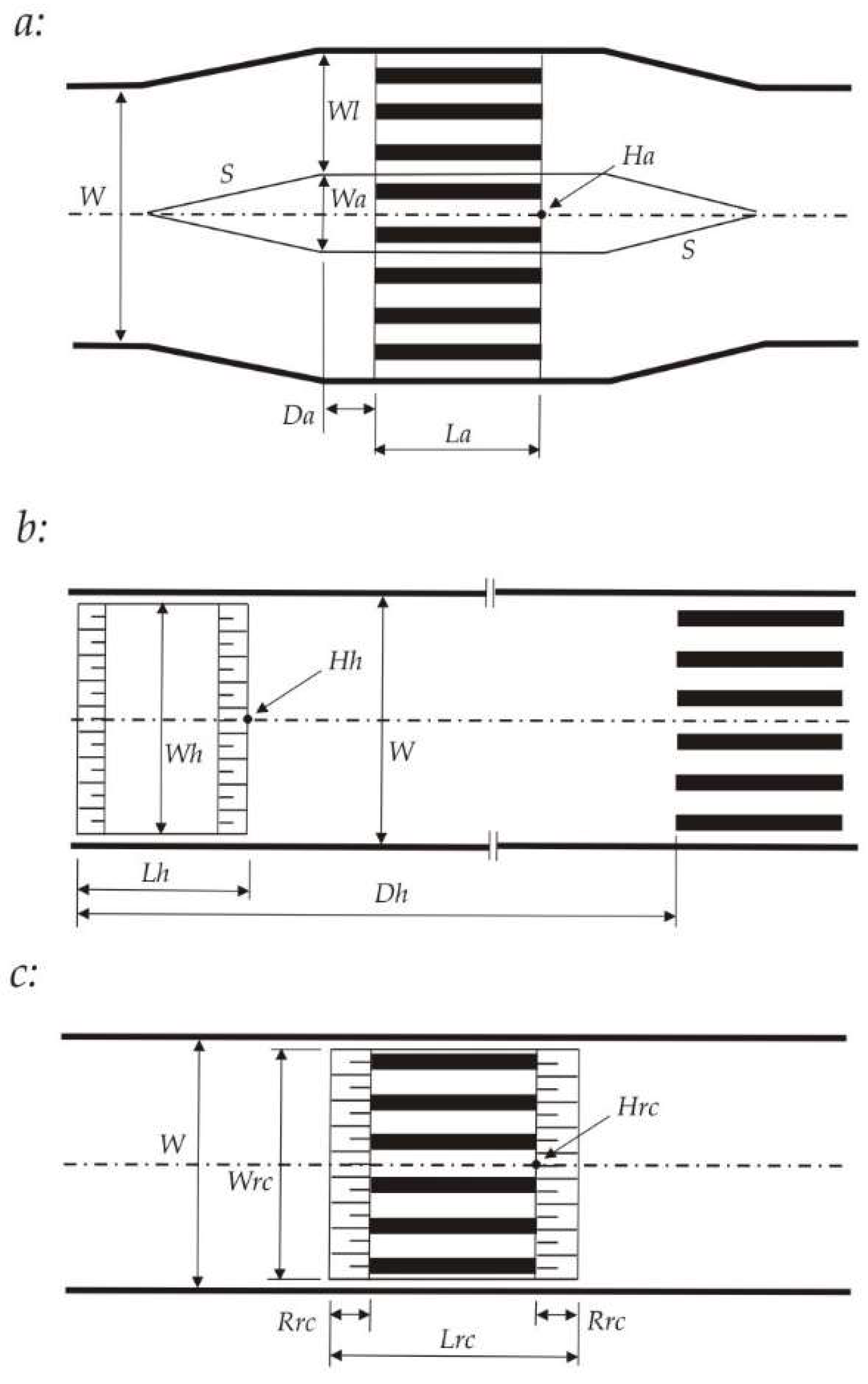
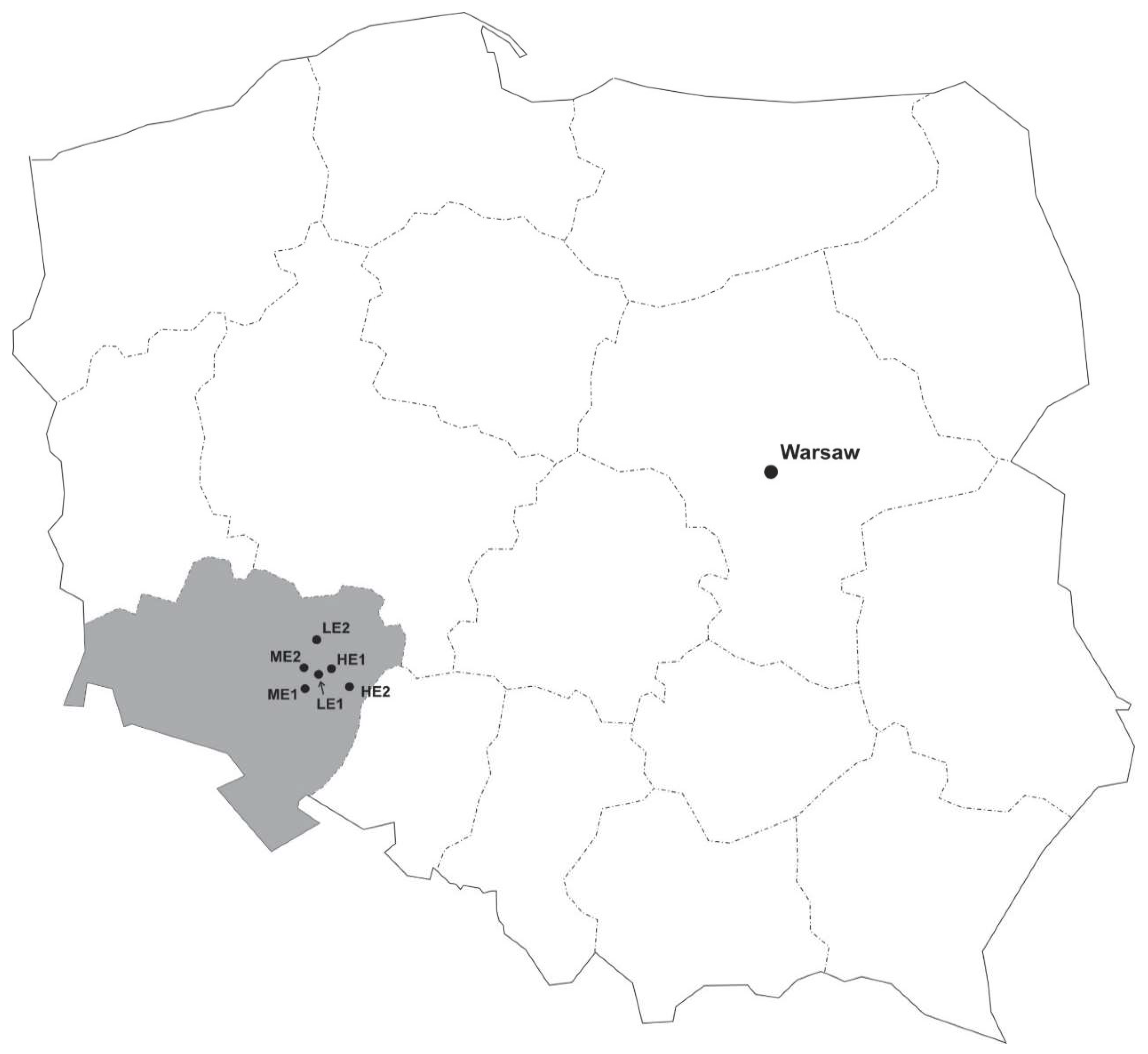
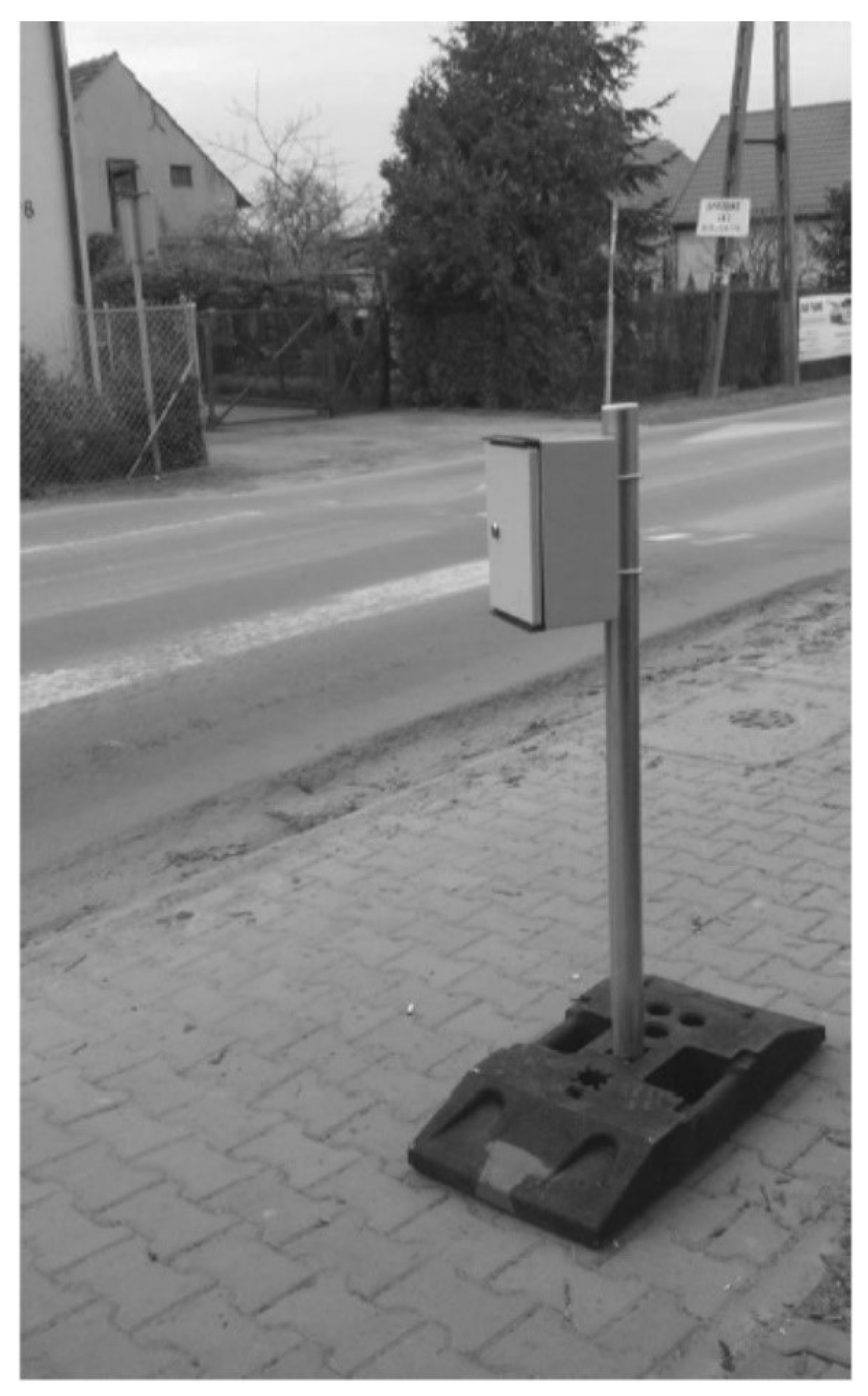

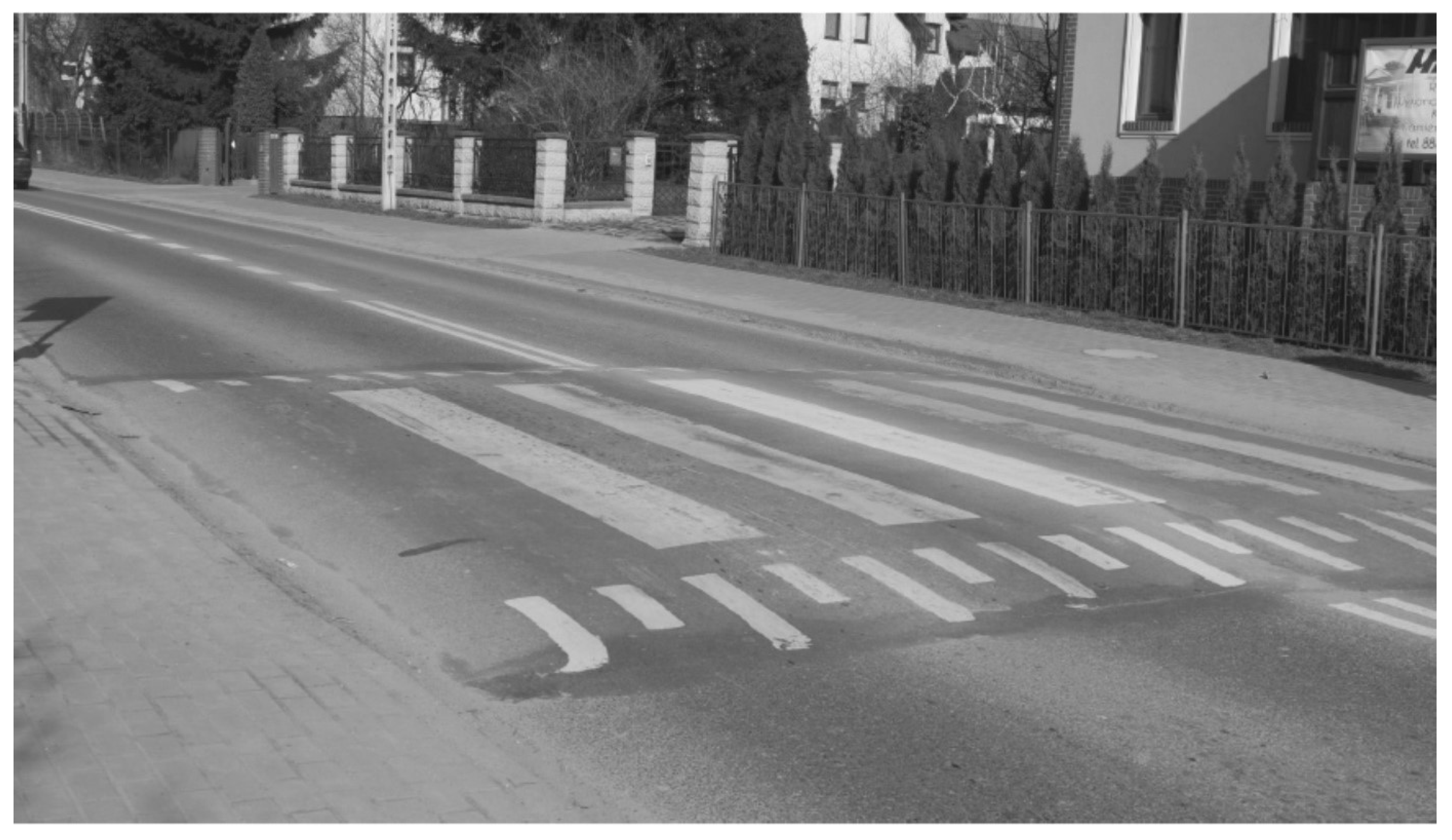


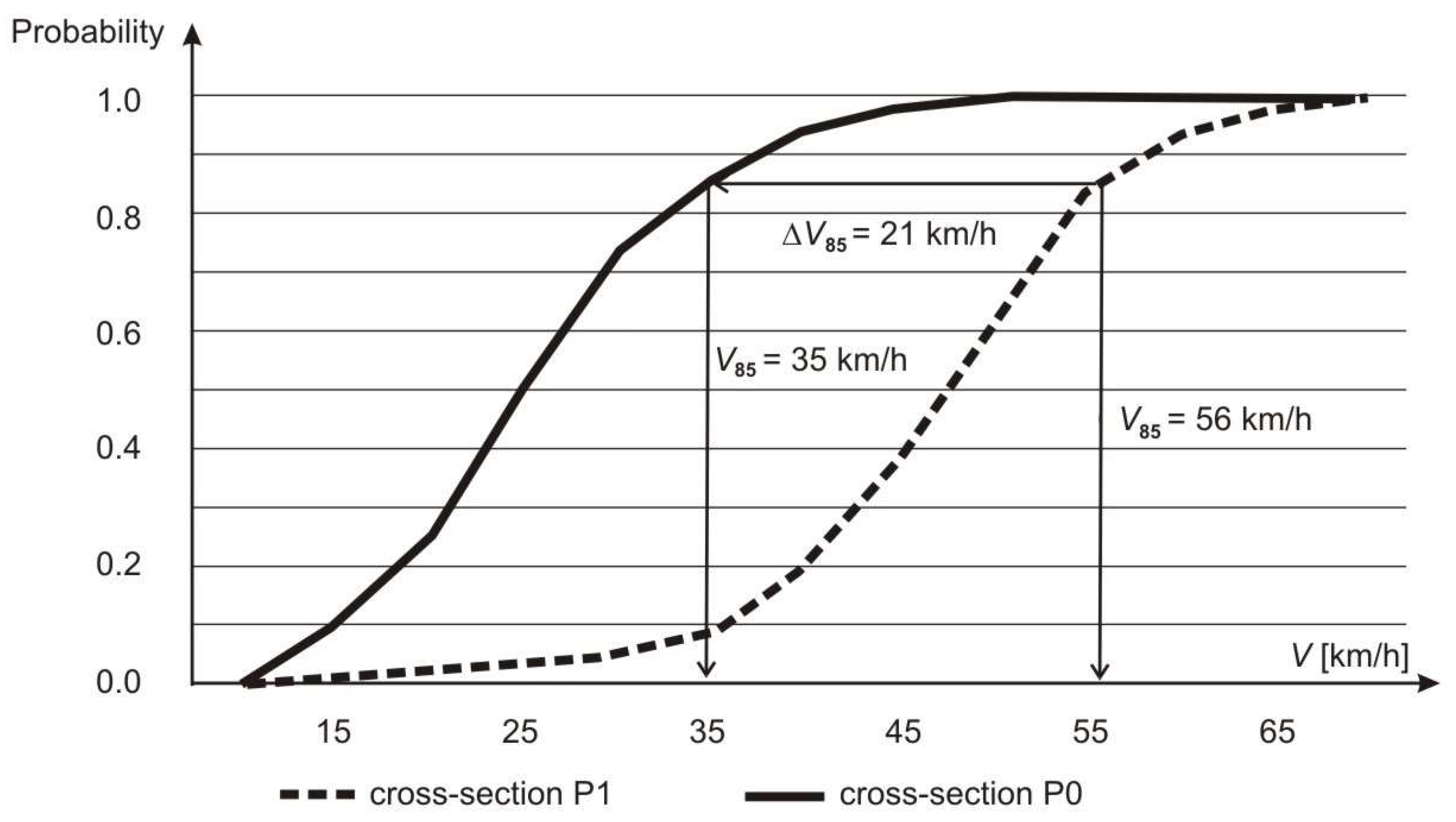



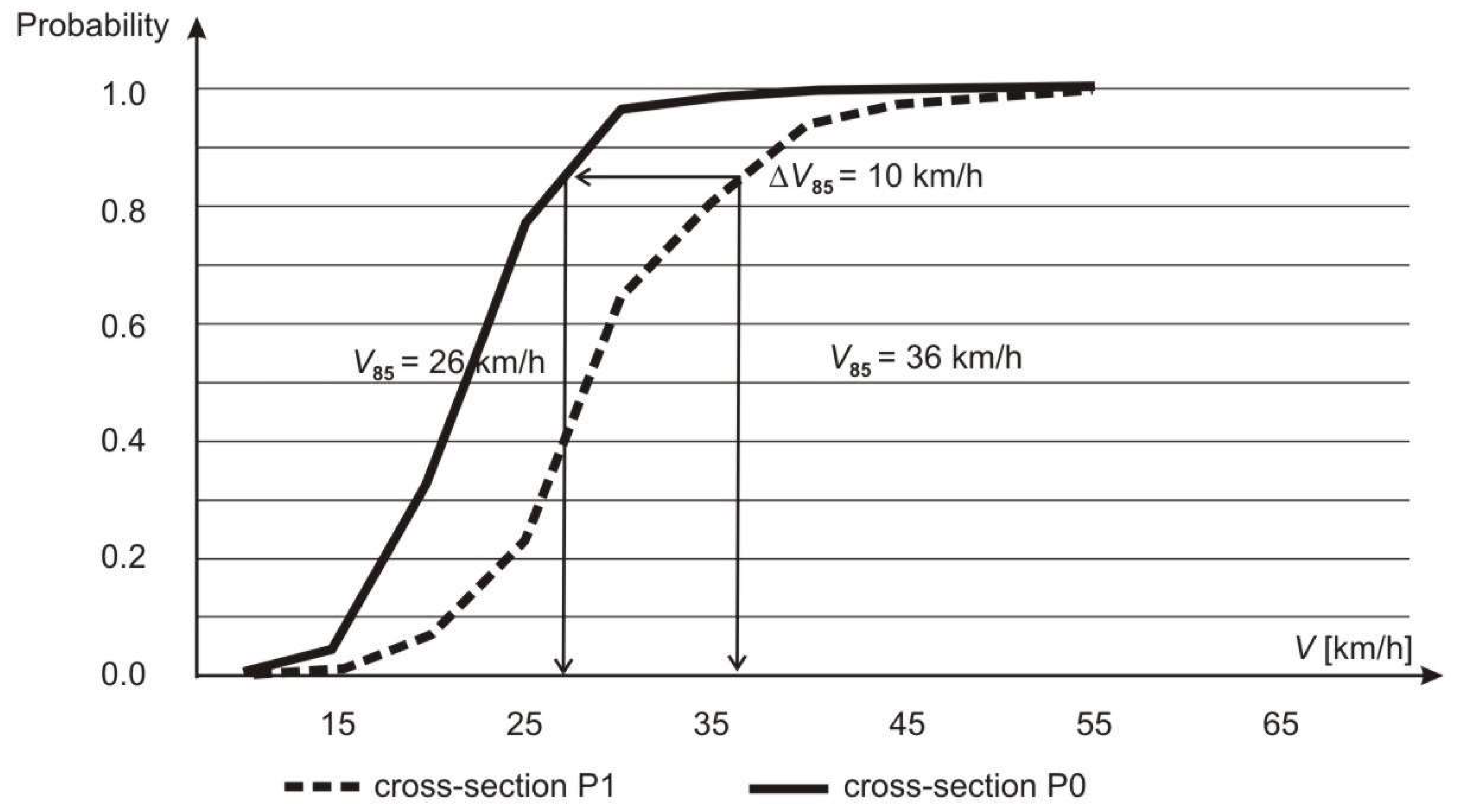




| Cross Section | Speed Characteristics | |||||||||
|---|---|---|---|---|---|---|---|---|---|---|
| V98 [km/h] | ZV98 [–] | V85 [km/h] | ZV85 [–] | [km/h] | [km/h] | σ [km/h] | WZV [–] | A [–] | K [–] | |
| Refugee islands | ||||||||||
| P0 | 65.2 | 0.034 | 56.5 | 0.026 | 48.2 | 0.029 | 8.4 | 0.174 | 0.039 | 0.124 |
| P1 | 67.7 | 58.3 | 50.0 | 8.4 | 0.169 | 0.179 | 0.020 | |||
| Speed tables | ||||||||||
| P0 | 44.1 | 0.040 | 36.4 | 0.063 | 30.4 | 0.063 | 6.3 | 0.208 | 0.311 | 0.383 |
| P1 | 46.4 | 39.5 | 33.0 | 6.6 | 0.199 | 0.206 | 0.328 | |||
| Raised crossings | ||||||||||
| P0 | 41.7 | 0.250 | 34.7 | 0.228 | 27.7 | 0.286 | 6.6 | 0.238 | 0.314 | 0.245 |
| P1 | 54.7 | 47.0 | 39.6 | 7.3 | 0.185 | 0.214 | 0.381 | |||
Publisher’s Note: MDPI stays neutral with regard to jurisdictional claims in published maps and institutional affiliations. |
© 2021 by the authors. Licensee MDPI, Basel, Switzerland. This article is an open access article distributed under the terms and conditions of the Creative Commons Attribution (CC BY) license (https://creativecommons.org/licenses/by/4.0/).
Share and Cite
Kruszyna, M.; Matczuk-Pisarek, M. The Effectiveness of Selected Devices to Reduce the Speed of Vehicles on Pedestrian Crossings. Sustainability 2021, 13, 9678. https://doi.org/10.3390/su13179678
Kruszyna M, Matczuk-Pisarek M. The Effectiveness of Selected Devices to Reduce the Speed of Vehicles on Pedestrian Crossings. Sustainability. 2021; 13(17):9678. https://doi.org/10.3390/su13179678
Chicago/Turabian StyleKruszyna, Maciej, and Marta Matczuk-Pisarek. 2021. "The Effectiveness of Selected Devices to Reduce the Speed of Vehicles on Pedestrian Crossings" Sustainability 13, no. 17: 9678. https://doi.org/10.3390/su13179678
APA StyleKruszyna, M., & Matczuk-Pisarek, M. (2021). The Effectiveness of Selected Devices to Reduce the Speed of Vehicles on Pedestrian Crossings. Sustainability, 13(17), 9678. https://doi.org/10.3390/su13179678







